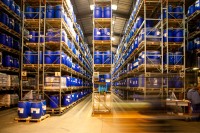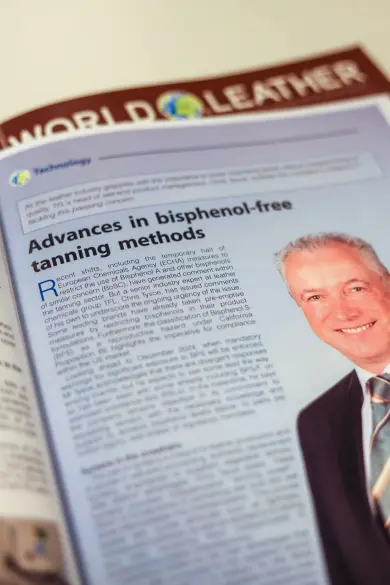Recent shifts, including the temporary halt of European Chemicals Agency (ECHA) measures to restrict the use of Bisphenol A and other bisphenols of similar concern (BoSC), have generated comment within the tanning sector. But a senior industry expert at leather chemicals group TFL, Chris Tysoe, has issued comments of his own to underscore the ongoing urgency of the issue. Some leading brands have already taken pre-emptive measures by restricting bisphenols in their product formulations. Furthermore, the classification of Bisphenol S (BPS) as a reproductive hazard under California Proposition 65 highlights the imperative for compliance within the US market.
Looking ahead to December 2024, when mandatory warnings for significant exposure to BPS will be enforced, Mr Tysoe acknowledges that there are divergent responses among brands, but he expects to see some lead the way, as has been seen with some already including BPS/F on restricted substance lists (RSLs). In the meantime, he says the company remains steadfast in its commitment to equipping tanners with the necessary knowledge and support to achieve bisphenol levels below 10 parts per million (ppm), well ahead of regulatory mandates.
Syntans in the crosshairs
The use of syntans is integral to leather production and is pivotal in wet-end processing. Authentic replacement syntans, engineered to supplant vegetable tannins, offer distinct advantages, Chris Tysoe states. These syntans possess indispensable “tanning power”, which is fundamental in converting wet blue and wet white intermediates into finished leather. They provide leather with crucial attributes such as tightness, fullness and softness, as well as resistance to fading and heat, rendering them indispensable in contemporary leather manufacturing.
Expanding further on the main advantages that syntans offer compared to the vegetable tannins they were brought in to replace, he tells World Leather that syntans and vegetable tannins have their own performance and characteristics profiles. The advantage of syntans is that they were designed with specific properties and for certain purposes, whereas with vegetable tannins, their properties are largely inherent and need to be “steered”, including through the use
of syntans. For this reason, syntans and vegetable tannins are complementary, and it is common to see both types of product exploited to the full in most recipes.
"Syntans possess indispensable ‘tanning power’ and provide leather with crucial attributes such as tightness, fullness and softness, as”well as resistance to fading and heat."
“Syntans tend to have a broader application profile and can be used in pretanning, tanning, retanning and even as dyeing auxiliaries,” he explains, “whereas currently no heavy leather is made with syntans alone.”
In response to the industry-wide imperative of reducing bisphenol content in leather production, there are various ways in which syntans can help tanners navigate the restrictions without compromising on quality.
Adherence to the guidelines
Foremost among TFL’s solutions is a spectrum of replacement syntans boasting ultra-low to zero bisphenol content. This range is said to enable tanners to produce diverse leather types, encompassing footwear, leathergoods, furniture upholstery, and automotive leather. By adhering to strict guidelines, the resulting articles can attain bisphenol levels below 10 parts per million or even reach non- detectable levels, ensuring compliance with stringent regulations while upholding product quality. Moreover, they ensure that all auxiliary chemicals employed in leather manufacturing processes are entirely free of bisphenols. This encompasses resins, retanning and softening polymers, dyestuffs, and fatliquors.
In addition to this, TFL has developed a tool for assessing bisphenol content in leather. This tool helps customers select suitable products in the appropriate quantities to achieve desired properties while complying with the regulations. Customers can also submit leather samples to the chemicals producer or to third-party laboratories for validation.
Carbon footprint advantages
A commitment to sustainability is evidenced by the introduction of an “ultra-low to zero” bisphenol syntan range in liquid form. This initiative aims to reduce energy consumption during production, consequently mitigating overall carbon footprint. Liquid products offer ecological benefits, health advantages, and automation efficiencies, TFL has pointed out. Nevertheless, the company remains adaptable to market demands, ensuring that powdered replacement syntans are available if required by certain customers in specific markets. TFL accommodates these preferences by providing both liquid and powdered variants of syntans. Mr Tysoe says the decision to opt for powdered products may be influenced by factors such as customers’ conservatism, storage constraints, or handling considerations. Nonetheless, he stresses the carbon footprint advantages of liquid syntans, taking into account the entire product lifecycle from raw materials to transportation.
Comprehensive support for bisphenol-free leather development encompasses innovative products, tools, and sustainability initiatives. By delivering effective solutions and accommodating customer preferences, TFL believes it is empowering tanners to navigate the regulatory challenges while still producing high-quality leather.
WORLD LEATHER APRIL/MAY 2024





 Main Reaction - The TFL Blog Stories, incidents, tips and facts around the topics leather, chemistry, fashion, sustainability and ecology. Our editorial staff consisting of experienced tanners, scientists, market experts, fashion and communication specialists has sharped their pencils and will supply you with fresh and inspiring content on a regular basis.
Main Reaction - The TFL Blog Stories, incidents, tips and facts around the topics leather, chemistry, fashion, sustainability and ecology. Our editorial staff consisting of experienced tanners, scientists, market experts, fashion and communication specialists has sharped their pencils and will supply you with fresh and inspiring content on a regular basis.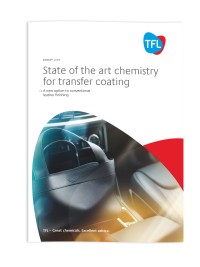
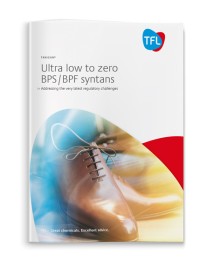
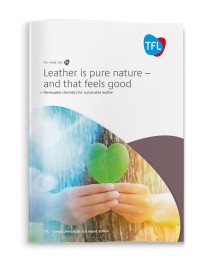
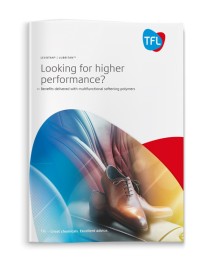 LEVOTAN® / LUBRITAN™ - Looking for higher performance? Tanners around the world are facing increasing challenges from their customers, for example, demands for higher performance such as fastness to light and heat resistance, but also lighter weight leather and more recently odour / emissions avoidance.
LEVOTAN® / LUBRITAN™ - Looking for higher performance? Tanners around the world are facing increasing challenges from their customers, for example, demands for higher performance such as fastness to light and heat resistance, but also lighter weight leather and more recently odour / emissions avoidance.






